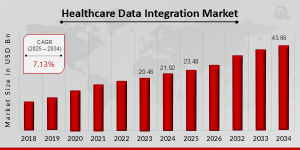Healthcare Data Integration Market to Hit $43.66 Billion By 2034, Connecting Care Through Data
Healthcare Data Integration Market is at a pivotal juncture, where technological evolution meets the urgent need for better healthcare delivery.
The global healthcare data integration market has witnessed significant growth in recent years, driven by the increasing adoption of digital health technologies, electronic health records (EHRs), and the growing need for interoperable systems that can streamline patient data management. Healthcare providers are now more focused than ever on enhancing patient care, operational efficiency, and decision-making capabilities. This has led to a surge in demand for data integration solutions that can consolidate information from various sources into unified platforms. Furthermore, the proliferation of wearable health devices, mobile health apps, and telemedicine has contributed to an exponential rise in data volumes, creating a compelling need for seamless data integration across different systems and platforms.
Get Exclusive Sample of the Research Report at -
https://www.marketresearchfuture.com/sample_request/26516
The healthcare data integration market is broadly segmented based on components, deployment mode, application, end-user, and region. In terms of components, the market is classified into tools and services. The tools segment encompasses software solutions used for data mapping, extraction, transformation, and loading (ETL), while services include consulting, implementation, and support. Based on deployment mode, the market is divided into cloud-based and on-premises models. The cloud-based segment is growing rapidly due to its scalability, cost-efficiency, and ease of access. From an application standpoint, healthcare data integration is utilized in medical records management, billing and claims, population health management, and clinical data integration. Among end-users, hospitals, clinics, research institutions, and health information exchanges (HIEs) are the primary adopters. Hospitals hold a dominant share owing to their need for efficient data exchange among multiple departments and stakeholders.
The dynamics of the healthcare data integration market are influenced by several factors, including technological advancements, regulatory requirements, and the growing focus on patient-centric care. On the one hand, government mandates for the adoption of EHRs and data standardization are pushing healthcare providers to embrace integration solutions. On the other hand, the increasing complexity of healthcare data—generated from disparate sources such as medical imaging systems, lab results, and patient portals—poses a challenge that can only be addressed through robust integration frameworks. Furthermore, the rise of value-based care models has prompted providers to rely on integrated data systems to measure outcomes and manage chronic diseases effectively. However, data privacy concerns and the lack of standardized data formats across different systems continue to hamper market growth to some extent.
Buy this Premium Research Report at -
https://www.marketresearchfuture.com/checkout?currency=one_user-USD&report_id=26516
In recent developments, the healthcare data integration space has seen a wave of innovation and strategic initiatives. Major vendors have launched cloud-native platforms that support HL7, FHIR, and other industry standards to ensure seamless interoperability. For instance, Oracle Health and Microsoft Cloud for Healthcare have introduced enhanced features for data aggregation, normalization, and patient insights. Additionally, AI and machine learning are increasingly being integrated into data platforms to enable predictive analytics and personalized medicine. The COVID-19 pandemic further accelerated digital transformation in healthcare, compelling organizations to prioritize remote patient monitoring and real-time data sharing, thus fueling demand for integration solutions. Several governments have also announced funding and policy initiatives aimed at improving healthcare IT infrastructure, thereby contributing to market expansion.
Regionally, North America holds the largest share of the healthcare data integration market, driven by the presence of advanced healthcare IT infrastructure, widespread adoption of EHR systems, and favorable regulatory frameworks such as the Health Information Technology for Economic and Clinical Health (HITECH) Act. The United States, in particular, leads in terms of investments and innovations in healthcare data technologies. Europe follows closely, with countries like Germany, the United Kingdom, and France showing strong growth due to government initiatives promoting digital health and data interoperability. The Asia-Pacific region is poised for rapid growth, fueled by increasing healthcare expenditures, rising patient awareness, and government-led initiatives to digitize healthcare services in countries like India, China, and Australia. Latin America and the Middle East & Africa are also gradually embracing healthcare IT solutions, albeit at a slower pace, due to infrastructural challenges and limited access to digital resources.
Browse In-depth Market Research Report -
https://www.marketresearchfuture.com/reports/healthcare-data-integration-market-26516
Key Companies in the Healthcare Data Integration Market Include
• Cerner
• SAP SE
• IBM Corporation
• Allscripts Healthcare Solutions
• Microsoft Corporation
• GE Healthcare
• Siemens Healthineers
• Epic Systems
• Dell Technologies
• Philips Healthcare
• Amazon Web Services
• Oracle Corporation
• McKesson Corporation
• NextGen Healthcare Information Systems
The healthcare data integration market is at a pivotal juncture, where technological evolution meets the urgent need for better healthcare delivery. As data becomes the cornerstone of clinical decision-making, the role of integration solutions will only grow more critical. While challenges like data security and standardization remain, ongoing innovations, supportive policies, and rising demand for coordinated care are expected to drive sustained market growth. Organizations that invest in agile, interoperable, and scalable integration solutions are likely to gain a competitive edge in delivering efficient and value-based healthcare in the years to come.
Explore MRFR’s Related Ongoing Coverage In ICT Domain -
Sram And Rom Design Ip Market -
https://www.marketresearchfuture.com/reports/sram-rom-design-ip-market-43047
Strategic Consulting Service Market -
https://www.marketresearchfuture.com/reports/strategic-consulting-service-market-42977
Sweat Powered Smartwatche Market -
https://www.marketresearchfuture.com/reports/sweat-powered-smartwatches-market-43026
Tag Management System Market
Volte Testing Market
About Market Research Future:
At Market Research Future (MRFR), we enable our customers to unravel the complexity of various industries through our Cooked Research Report (CRR), Half-Cooked Research Reports (HCRR), Raw Research Reports (3R), Continuous-Feed Research (CFR), and Market Research & Consulting Services.
MRFR team have supreme objective to provide the optimum quality market research and intelligence services to our clients. Our market research studies by products, services, technologies, applications, end users, and market players for global, regional, and country level market segments, enable our clients to see more, know more, and do more, which help to answer all their most important questions.
Contact US:
Market Research Future
(Part of Wantstats Research and Media Private Limited)
99 Hudson Street, 5Th Floor
New York, NY 10013
United States of America
+1 628 258 0071 (US)
+44 2035 002 764 (UK)
Email: sales@marketresearchfuture.com
Website: https://www.marketresearchfuture.com
Website: https://www.wiseguyreports.com/
Website: https://www.wantstats.com/
Sagar Kadam
Market Research Future
+ +1 628-258-0071
email us here
Visit us on social media:
LinkedIn
Facebook
X
Legal Disclaimer:
EIN Presswire provides this news content "as is" without warranty of any kind. We do not accept any responsibility or liability for the accuracy, content, images, videos, licenses, completeness, legality, or reliability of the information contained in this article. If you have any complaints or copyright issues related to this article, kindly contact the author above.
Georgia Ministry Recognized for Transformational Charity Work
Inks & Bindings Presents Bold New Voices at the 2025 Los Angeles Times Festival of Books
Maureen Anne Meehan Debuts Legal Thriller at L.A. Times Festival of Books 2025
Kalendarium
Więcej ważnych informacji
 Jedynka Newserii
Jedynka Newserii

 Jedynka Newserii
Jedynka Newserii

Praca

Ogromna baza magazynowa zbóż w Wielkopolsce do likwidacji. Pracę może stracić kilkaset osób
Baza magazynowa zbóż w Witoldowie to obiekt zarządzany od 30 lat przez spółkę Top Farms Wielkopolska, która prowadzi działalność na gruntach dzierżawionych z Zasobów Skarbu Państwa. Teraz baza ma zostać rozebrana, a wydzierżawiona ziemia – trafić do Zasobu Własności Rolnej Skarbu Państwa. Spółka Top Farms wnioskowała do KOWR-u o utworzenie ośrodków produkcji rolniczej, które umożliwiłyby dalsze funkcjonowanie wielu takich strategicznych obiektów rolniczych. Brak decyzji KOWR jest zagrożeniem dla stabilności dużych, nowoczesnych gospodarstw towarowych, a tym samym również dla bezpieczeństwa żywnościowego Polski.
Konsument
Eksperci apelują do Ministerstwa Zdrowia o zmianę w polityce nikotynowej. Powinna lepiej chronić dzieci i młodzież

Wprowadzanie kolejnych zakazów w ustawie tytoniowej nie przyniesie spodziewanego rezultatu – oceniają lekarze i terapeuci pracujący z osobami uzależnionymi. Według nich należy osobno rozpisać działania rozwiązujące problem na poziomie osób dorosłych, które już palą, i te, które będą nakierowane na ochronę dzieci i młodzieży przed dostępem do wyrobów nikotynowych. Stowarzyszenie Jump93 wraz z przedstawicielami środowisk psychiatrycznych i zdrowia publicznego zaapelowało o systemowe podejście do polityki nikotynowej, z uwzględnieniem potencjału strategii redukcji szkód.
Bankowość
Rynek oczekuje pierwszego cięcia stóp procentowych w Polsce w maju. Są ku temu przesłanki ekonomiczne

Na podstawie ostatnich wypowiedzi prof. Adama Glapińskiego, przewodniczącego Rady Polityki Pieniężnej, ekonomiści oczekują, że już na posiedzeniu 7 maja może zapaść pierwsza od ponad półtora roku decyzja o zmianie poziomu stóp procentowych w dół. RPP dostosuje się w ten sposób do polityki głównych banków centralnych oraz słabnącej presji inflacyjnej. Zdaniem prezesa Q Value będzie to działanie w dobrym kierunku, choć spóźnione i być może spowodowane czynnikami politycznymi.
Partner serwisu
Szkolenia

Akademia Newserii
Akademia Newserii to projekt, w ramach którego najlepsi polscy dziennikarze biznesowi, giełdowi oraz lifestylowi, a także szkoleniowcy z wieloletnim doświadczeniem dzielą się swoją wiedzą nt. pracy z mediami.








.gif)

 |
| |
| |
|